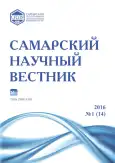Study of floristic structure of the territory using family range in the Sok River basin (Samara Region, Zavolzhye, forest-steppe zone)
- Authors: Ivanova A.V.1, Kostina N.V.1
-
Affiliations:
- Institute of Ecology of the Volga River Basin of Russian Academy of Sciences
- Issue: Vol 5, No 1 (2016)
- Pages: 26-31
- Section: 03.02.00 – General Biology
- URL: https://journals.rcsi.science/2309-4370/article/view/21951
- DOI: https://doi.org/10.17816/snv20161105
- ID: 21951
Cite item
Full Text
Abstract
Ecological approach to the study of flora implies an integral flora unit called elementary flora (EF), which is usually regarded as the elementary unit of floristic division. Identification of the minimum-range of EF is prerequisite for the research of flora of any territory. The aim of this research is to identify the number of EF in the research area (floral patterns) by comparing the values of certain parameters of the family range of flora in four minimum-ranges. The basin of the river Sok is the research area. Its landscape zoning varies in different literature sources. Florae of the four minimum-range habitats are formed on territorial basis with reference to the existing floristic descriptions. The following parameters of the family range of flora in four minimum-ranges were used: establishment of the order of the first triad of families depending on number of species in a sample, percentage of monotypic families and percentage of species in the top ten families. The considered values of florae parameters in the sample areas corresponding to the minimum-range habitats show a certain degree of similarity. The largest differences were observed in the study of the formation of top three leading families, depending on the number of species. This indicator reflects the peculiarities of individual sample areas due to the variety of intra-landscape. The authors reach a conclusion concerning the conditional affiliation of the researched territory to one EF. The conclusion is based on the analyzed parameters of the family range of flora of all minimum-ranges as well as their floristic descriptions.
Full Text
##article.viewOnOriginalSite##About the authors
Anastasia Viktorovna Ivanova
Institute of Ecology of the Volga River Basin of Russian Academy of Sciences
Author for correspondence.
Email: nastia621@yandex.ru
candidate of biological sciences, researcher of the Laboratory of Problems of Phytodiversity
Russian Federation, TogliattiNatalia Viktorovna Kostina
Institute of Ecology of the Volga River Basin of Russian Academy of Sciences
Email: knva2009@yandex.ru
candidate of biological sciences, senior researcher of the Laboratory of Modeling and Management of Ecosystems
Russian Federation, TogliattiReferences
- Толмачев А.И. Богатство флор как объект сравнительного изучения // Вестник ЛГУ. 1970. № 9. С. 71-83.
- Толмачев А.И. Введение в географию растений. Л.: ЛГУ, 1974. 244 с.
- Юрцев Б.А. Некоторые тенденции развития метода конкретных флор // Ботанический журнал. 1975. № 1. С 69-83.
- Юрцев Б.А. Элементарные естественные флоры и опорные единицы сравнительной флористики // Теоретические и методические проблемы сравнительной флористики: Материалы II рабочего совещания по сравнительной флористике. Л.: Наука. 1987. С. 47-66.
- Юрцев Б.А., Семкин Б.И. Изучение конкретных и парциальных флор с помощью математических методов // Ботанический журнал. 1980. Т. 65, № 12. С. 1706-1718.
- Лукичева А.Н., Сабуров Д.Н. Конкретная флора и флора ландшафта // Ботанический журнал. 1969. № 12. С. 1911-1920.
- Физико-географическое районирование Среднего Поволжья / Под ред. А.В. Ступишина. Казань: Изд-во Казанского ун-та, 1964. 173 с.
- Чибилев А.А., Дебело П.В. Ландшафты Урало-Каспийского региона. Оренбург: Институт степи УрО РАН, Печатный дом «Димур», 2006. 264 с.
- Кузнецова Р.С. Бассейн реки Сок: общая характеристика притоков // Известия Самарского научного центра РАН, 2014. Т.16, № 5. С. 36-42.
- Костина М.А. База данных «Флористические описания локальных участков Самарской и Ульяновской областей» (FD SUR): информационная основа, структура данных, алгоритмы обработки и результаты использования // Самарская Лука: проблемы региональной и глобальной экологии. 2015. Т. 24, № 2. С. 161-172.
- Иванова А.В., Костина Н.В. Выявление площади минимум-ареала конкретной флоры с учетом антропогенной трансформации территории // Известия Самарского научного центра РАН, 2015. Т. 17, № 4. С. 77-80.
- Клаус К. Флоры местные и приволжских стран. СПб., 1852. 312 с.
- Хохряков А.П. Таксономические спектры и их роль в сравнительной флористике // Ботанический журнал. 2000. Т. 85. № 5. С. 1-11.
- Иванова А.В., Костина Н.В. Характеристика флоры Самарского Заволжья по семейственному спектру // Самарский научный вестник. 2015. № 2 (11). С. 86-89.
- Саксонов С.В., Сенатор С.А. Путеводитель по Самарской флоре (1851-2011). Флоры Волжского бассейна. Т. 1. Тольятти: Кассандра, 2012. 512 с.
- Иванова А.В., Васюков В.М. Особенности таксономической структуры флоры Серноводского шихана и его окрестностей (Высокое Заволжье, Самарская область) // Степи Северной Евразии: Материалы VI международного симпозиума и VI международной школы-семинара «Геоэкологические проблемы степных регионов» / под научной редакцией члена-корреспондента РАН А.А. Чибилева. Оренбург: ИПК «Газпромпечать» ООО «Оренбурггазпромсервис», 2012. С. 310-313.
- Бакин О.В., Рогова Т.В., Ситников А.П. Сосудистые растения Татарстана. Казань: Изд-во Казан. ун-та, 2000. 496 с.
- Тарасова Е.М. Флора Вятского края. Часть 1. Сосудистые растения. Киров: ОАО «Кировская областная типография», 2007. 440 с.
- Иванова А.В. Изучение изменения таксономических показателей локальных флор различных физико-географических районов Самаро-Ульяновского Поволжья // Экология и география растений и сообществ Среднего Поволжья. Тольятти: Кассандра, 2014. С. 170-174.
- Preston F.W. The canonical distribution of commonness and rarity // Ecologoy. 1962. no.3. P. 410-432.
- Костина Н.В. Применение индексов сходства и различия для районирования территорий на основе локальных флор // Известия Самарского научного центра РАН. 2013. Т. 15. № 3(7). С. 2160-2168.
Supplementary files













